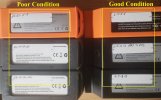No expert in battery tech, I have a four cell battery's I conducted two tests
This was done on a battery that is in storage "mode"
Battery starting cell 1 = 3.81v, 3.82v, 3.82v, and 3.82v
Battery resistance cell 1 - 005, 006, 007 ,008 Ohm's
Why are the resistance no the same or is that normal
This was done on a battery that is in storage "mode"
Battery starting cell 1 = 3.81v, 3.82v, 3.82v, and 3.82v
Battery resistance cell 1 - 005, 006, 007 ,008 Ohm's
Why are the resistance no the same or is that normal



